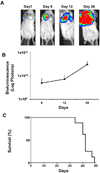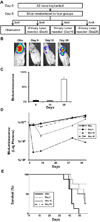Resection of the primary tumor improves survival in metastatic breast cancer by reducing overall tumor burden
- PMID: 23489938
- PMCID: PMC3664113
- DOI: 10.1016/j.surg.2013.02.002
Resection of the primary tumor improves survival in metastatic breast cancer by reducing overall tumor burden
Abstract
Background: Although many retrospective studies suggest that resection of the primary tumor improves survival in metastatic breast cancer, animal studies suggest that resection induces metastasis. Moreover, there has been no critical evaluation of how well animal studies actually model metastatic breast cancer. We used our newly established orthotopic cancer implantation under direct vision model to evaluate the hypothesis that primary tumor resection improves survival in metastatic breast cancer by reducing overall tumor burden and improving immune responsiveness.
Methods: Murine mammary adenocarcinoma 4T1-luc2 cells that can be visualized by bioluminescence were implanted orthotopically into BALB/c mice under direct vision. Resection of the primary tumors at days 6, 10, and 28 were compared to sham resection of the contralateral normal mammary gland and observation alone. Tumor burden was quantified by bioluminescence. Tumor-draining lymph nodes were identified by intradermal injection of lymphazurin, and primary tumors, lymph nodes, and lungs were examined pathologically. Kaplan-Meier survival analyses were performed. Splenocyte myeloid-derived suppressor cells (MDSCs) and CD4 or CD8 single positive T lymphocytes were quantified by flow cytometry.
Results: Tumors invaded locally, metastasized to regional lymph nodes, and then metastasized to distant organs, with subsequent mortality. Surgical stress increased tumor burden only transiently without affecting survival. When primary tumor resection decreased overall tumor burden substantially, further growth of metastatic lesions did not increase the overall tumor burden compared to observation, and survival was improved, which was not the case when resection did not significantly reduce the overall tumor burden. Decreasing overall tumor burden through resection of the primary tumor resulted in decreased splenic MDSC numbers and increased CD4 and CD8 cells, suggesting the potential for an improved immunologic response to cancer.
Conclusion: Decreasing overall tumor burden through resection of the primary breast tumor decreased MDSCs, increased CD4 and CD8 cells, and improved survival.
Copyright © 2013 Mosby, Inc. All rights reserved.
Figures





References
-
- DeSantis C, Siegel R, Bandi P, et al. Breast cancer statistics, 2011. CA Cancer J Clin. 61:409–418. - PubMed
-
- Leung AM, Vu HN, Nguyen KA, et al. Effects of surgical excision on survival of patients with stage IV breast cancer. J Surg Res. 161:83–88. - PubMed
-
- Cady B, Nathan NR, Michaelson JS, et al. Matched pair analyses of stage IV breast cancer with or without resection of primary breast site. Ann Surg Oncol. 2008;15:3384–3395. - PubMed
-
- Rao R, Feng L, Kuerer HM, et al. Timing of surgical intervention for the intact primary in stage IV breast cancer patients. Ann Surg Oncol. 2008;15:1696–1702. - PubMed
-
- Rapiti E. Complete excision of primary breast tumor improves survival of patients with metastatic breast cancer at diagnosis. J Clin Oncol. 2006;24:2743–2749. - PubMed
Publication types
MeSH terms
Grants and funding
LinkOut - more resources
Full Text Sources
Other Literature Sources
Medical
Research Materials

